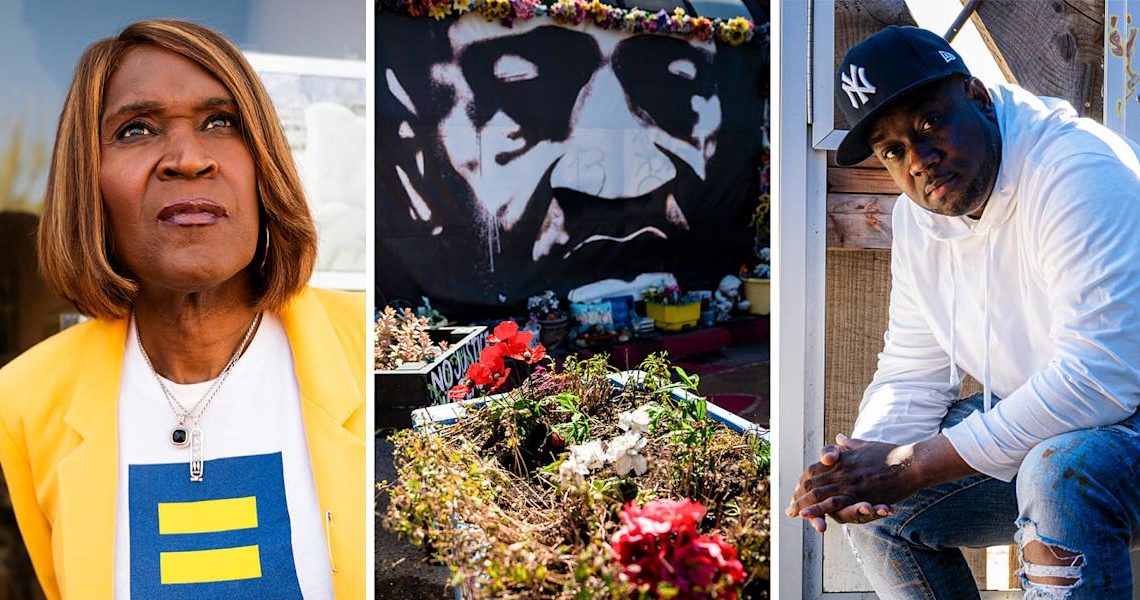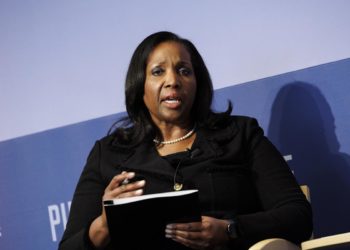MINNEAPOLIS — Nine minutes and 29 seconds was enough time for 46 cars to pass 38th Street and Chicago Avenue.
In the same 9 minutes and 29 seconds, 18 customers went in and out of the convenience store on the corner. Six patrons bought beverages or snacks from the coffee shop across the street. Four people signed up for a guided tour of the neighborhood in front of the gas station. Four visiting Chicagoans took pictures of the flowers, stuffed animals, potted plants, posters and other ephemera that form a makeshift memorial.
For 9 minutes and 29 seconds on May 25, 2020, Minneapolis police officer Derek Chauvin pressed his knee and the weight of his body against George Floyd’s neck at this very intersection. As Floyd called for his mother in his final words, Chauvin killed him in the street as people watched. Two officers held the unarmed, handcuffed Black man down. A third monitored the crowd that was stunned by what it witnessed.
“That’s a long time to kill a man,” said Mattie Atta, who spent a few minutes surveying the area before she left, shaking her head.
In less than 10 minutes, Floyd’s young daughter was left fatherless. The deadly series of events began because her dad was suspected of passing a counterfeit $20 bill. He was 46 years old.
What followed five years ago was an uprising that resulted in burned buildings and cars, and looting throughout Minneapolis, but was largely peaceful in parts of the country. Floyd’s murder prompted outraged responses from politicians, businesses, schools and other institutions nationwide, with vows to deal with America’s deep-seated racial injustices. Companies pledged more than $66 billion for racial equity initiatives. Cries for police reform were thrust into the forefront.
Now, five years later, many of those same lawmakers, companies and institutions have pulled back from those commitments.
Donald Trump’s return to the White House this year marked the end of many widespread initiatives announced in Floyd’s name, some of which were already winding down, forgotten or being purposefully abandoned.
Five years later in this previously nondescript area of Minneapolis, hardly anyone could agree on whether things have gotten better here. Or worse.
“That’s a challenging question,” said Andrea Jenkins, council member of Ward 8, where the tragedy occurred.
Samar Moseley, who drives a city bus in Minneapolis, said “everything about the city has been exposed since George Floyd.”
Before the murder, the neighborhood was a distressed community. Gang members frequented the area and used the convenience store, Cup Foods — changed to Unity Foods in 2023 — as a meeting post, community members told NBC News. Crime and drugs were prevalent at times. And the relationship between Black men and the police was atrocious, they said.
But after those 9 minutes and 29 seconds, Minneapolis police officers’ strained relationship with Black citizens intensified. Protests led to casualties, weeks of rampant looting and a police station being set afire. More than 300 officers quit in the aftermath.
“It was a little tough for all of us,” said Charles Adams, the North Minneapolis police inspector who has been in law enforcement in the area for 40 years. Adams is Black. He said he was so bothered by the video of the murder that he could not watch it all. “We were catching more flak from white folks than Blacks. Black people actually were my support mechanism. They were upset for sure, but they treated me the same. White people were giving me the finger while wearing Black Lives Matter T-shirts.”
“That one incident put us back to the 1960s,” Adams said.
After Floyd’s killing, the Department of Justice’s Civil Rights Division launched lawsuits and oversight in several cities across the U.S., including Minneapolis, in response to calls for reform.
“The relationship with police has always been a problem,” Moseley said. “It’s easing up some, but there’s still tension.”
He said he was so distraught about Floyd’s murder and the contentious relationship with police that he was inspired to write the song “Black Tears,“ which spoke to the trauma brought on by the murder at a place he frequented.
“What we felt after George Floyd was real pain, and this song was a way for me to get out some of what we all were feeling,” Moseley said. “It was like therapy for me.” He said the pain has subsided some over five years, but not the anxiety. Even while driving the bus, when a police car rides behind him, tension rises in him, he said.
“It’s crazy that I can be on my job and I feel uncomfortable when that happens,” he said. “But there are so many cases of someone doing nothing and ending up dead or in a battle with cops. It’s part of my PTSD. I think the whole city is still suffering from PTSD after George Floyd.”
After the uproar around Floyd’s death settled, the intersection, now George Floyd Plaza, transitioned from a rallying spot for protests that lasted months into a popular a location for visitors curious to see where a man lost his life, or to pay homage to Floyd.
“It’s a cool place and most people get along,” Moseley said. “But I think it’s kind of misunderstood because it’s a dangerous city, too.”
Gang presence has decreased in the area, while crime, still a concern, has leveled off this year after an uptick in homicides and carjackings in 2024.
But earlier this month, Trump’s Justice Department dismissed lawsuits and ended the oversight programs for local police departments across the country, including in Minneapolis, ending investigations into patterns of unconstitutional behavior, such as discrimination against Black people.
‘Life before and after George Floyd’
Jenkins, the council member, identifies the arc of her life in two segments: “Before George Floyd and after George Floyd.”
“There have been a number of changes, and yet it feels like things are very much the same,” she said.
Before Floyd’s murder, she was known as the first Black, openly transgender woman elected to public office in America. Elected in 2018, she had been diagnosed with multiple sclerosis a year earlier. But that did not stop Jenkins from tending to her neighborhood on foot, shopping at Cup Foods, frequenting local businesses and greeting her constituents on the street.
After Floyd was killed, she found herself in the center of a political and social maelstrom that led to a decline in her health, she said. Because the president of the city council was out of town on May 25, 2020, and unreachable, Jenkins, the vice president, was thrust onto the response leadership team.
During the protests, she took calls every two hours nightly — 1 a.m., 3 a.m., 5 a.m. — with members of the federal Bureau of Alcohol, Tobacco, Firearms and Explosives, the Hennepin County Sheriff’s Department, Minnesota State Patrol, the FBI and other agencies. Because of construction, siren-blaring ambulances headed to the local hospital were rerouted through her neighborhood, adding to the noise.
“It was so chaotic,” Jenkins recalled. “Not only the calls and the traffic, but there were helicopters whirling above. There was gunfire. And this happened virtually all night.”
Five years later, Jenkins said she routinely stays up until 4 a.m.
“My sleep habits have been deeply challenged. It’s part of my PTSD,” she said. “Even though it got quiet after a while, I still haven’t been able to get back to my old sleeping pattern.”
Before Floyd’s death, she did not move about the community on a motorized scooter as she does now. “I do have multiple sclerosis, but it’s exacerbated by the stress,” Jenkins said. “It’s all added up.”
She is in her last term on the city council. Jenkins wants to retire to focus on her health, leaving a legacy of having led her community through a torturous time.
She helped create a crisis response team that deploys violence interrupters, or specialists who work to defuse conflicts, in situations where people experience mental health issues. It’s an alternative to police officers “showing up with guns,” Jenkins said. Additionally, there’s now a Department of Neighborhood Safety — a network that includes the Minnesota Police Department, fire and emergency management services, 911 operators and the violence interrupters — that works to prevent and react to crime.
The biggest transformation, however, may have been in attitude. Some community members have argued in favor of dismantling the Floyd memorial next to Unity Foods. Others in the community have fought back by standing up for it in unison and patrolling against vandals.
“There is a stronger sense of community that has grown, particularly at this intersection,” Jenkins said. “A lot of people had been just floating through life. But I think now many have found a sense of purpose in coming together and protecting the square.”
Reflection and connection
Building trust within a community that already had severe distrust in the police was daunting — and is ongoing. That was not enough to sway veteran officer Adams’ daughter, Britteny, from joining the force. She found an organization under intense scrutiny.
But last year, Minneapolis experienced its first increase in recruits in five years — 76 new hires, a 133% surge. Adams said about 40 of those new hires are Black.
“I’m surprised,” he said. “But the good news is that they say they want to be a part of the change.”
Six months ago, C. Terrence Anderson opened Bichota, a coffee shop less than 50 feet from the site of Floyd’s murder. It was an intentional location.
“Every neighborhood deserves to have places to gather and just be and find peace and joy and all this connection with their community,” Anderson, 37, said. “I wasn’t deterred by the location. In fact, I found more purpose being here in this context.”
His business is part of the revitalization project that is underway to bring more commerce and amenities to the area. At 7 a.m. on weekday mornings, he meets with other business owners at the gas station on the corner to discuss how to strengthen their corridor with jobs, housing and cultural preservation. A cultural healing center is planned, as well as efforts for a formal memorial to Floyd.
“My mother’s Puerto Rican, and Bichota means, essentially, the joy and confidence that you find in succeeding in a place you’re not meant to succeed,” Anderson said. “That’s the ethos behind this space.”
For Anderson, who moved to Minneapolis from Los Angeles 10 years ago, this is all in line with his mission.
“I feel like even though you look out our windows and you can see our tragedy, I think what people feel in here is joy, peace and connection,” he said. “In other words, we’re saying you shouldn’t stop living. In fact, we should learn from what happened across the street to find a future that’s different and better.”
This article was originally published on NBCNews.com
The post In 9 minutes and 29 seconds, George Floyd was killed, forever changing this neighborhood appeared first on NBC News.




